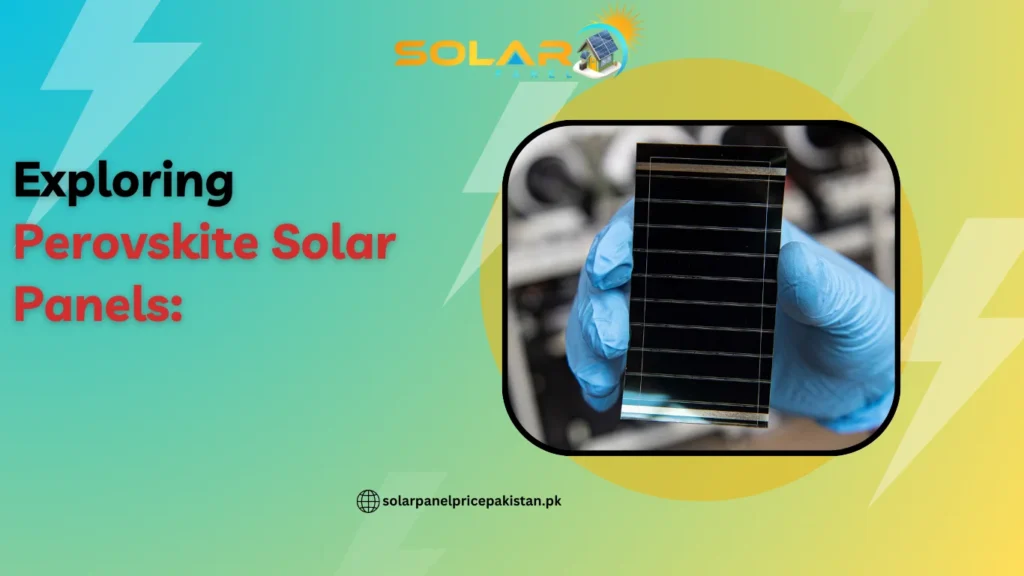Exploring Perovskite Solar Panels: A Bright Future for Pakistan
In recent years, the world has been excited with the potential of a revolutionary new technology that can change how we use energy. That technology is perovskite solar panels. As Pakistan is searching for new ways to increase its energy sources and reduce its dependence on traditional fossil fuels, it can be very beneficial to understand how these panels work. This blog will explore what perovskite is, how these solar cells work, their benefits, and their promising future.

What is Perovskite?
Perovskite refers to a specific crystal structure. This crystal was discovered in a mineral found in the Ural Mountains of Russia. However, in the context of solar panels, perovskite materials are a group of compounds that have this unique structure and have great properties for absorbing sunlight. Then, they can convert this sunlight into electricity. Therefore, the discovery of these materials has opened new ways in the development of solar cells due to their impressive efficiency and versatility.
How Do Perovskite Solar Panels Work? Getting a Deeper Look:
Perovskite solar cells work by using a thin film of perovskite material which is deposited onto a surface like glass or plastic. This layer absorbs sunlight and generates electrons. These electrons are then collected by electrodes to produce electricity. The process involves several layers. Each layer has a specific function to maximize the absorption of sunlight and the transportation of electrons.
The key components of these layers include:
- Light Absorbing Layer: The perovskite material itself, which captures sunlight and excites electrons.
- Electron Transport Layer: It allows the movement of electrons to the electrode.
- Hole Transport Layer: It moves the positively charged ‘holes’ (the absence of an electron) to the other electrode.
- Electrodes: These are conductive layers that collect the electrons and holes to generate a current.
This layered structure allows perovskite solar cells to achieve high efficiencies due to which it performs better than traditional silicon-based solar panels.
Benefits of Perovskite Solar Cells-A Game Changer Technology:
Perovskite solar cells offer several advantages that make them a great option for solar energy generation, particularly in a country like Pakistan. Here are a few advantages:
1. Improved Efficiency
Perovskite solar panels are known for their high-efficiency rates. They have shown the ability to convert a great portion of sunlight into electricity and often reach efficiencies of over 25% in lab conditions. This means that they can produce more electricity from the same amount of sunlight compared to many other types of solar panels.
2. Cost Effective
One of the most amazing benefits of perovskite solar panels is their potential for low production costs. The materials used in perovskite solar cells are abundant and inexpensive. In addition to that, the manufacturing process can require less energy compared to silicon-based solar cells. As a result, this can significantly reduce the overall cost of solar panel production.
3. Lightweight
Perovskite solar cells are more lightweight and flexible unlike traditional rigid and heavy solar panels. This flexibility provides many other benefits. Such as allowing you to use them into building materials, wearable technologies, and other portable solar devices. Moreover for homeowners in Pakistan, this means that you can install them more easily without putting too much structural stress on rooftops.
4. Tunable Bandgaps
Some special materials, like perovskites, have a unique property called “tunable bandgaps”. This means scientists can adjust how well the material absorbs different energies of light. By adjusting the properties of perovskite materials, scientists can create multiple layers that work together to capture more sunlight. Each layer is like a special filter. By stacking these layers, they can make super-efficient solar cells that turn more sunlight into electricity.
5. Compatible with Current Solar Cells
Perovskite solar panels can be used with existing silicon solar cells to work alongside them. This compatibility means that current solar technology infrastructure can be changed and improved with perovskite materials. This way, you will not have to change the entire solar system to enhance your current solar power efficiency.
Perovskite’s Promising Path-Moving Towards a Brighter Future
The future of perovskite solar panels looks incredibly promising. Researchers are continuously working on solving current challenges such as long-term stability. Once these issues are addressed, we can expect perovskite solar cells to become an amazing option for both home use and commercial use.
In Pakistan, the adoption of perovskite solar technology can revolutionize the energy sector. As many parts of the country get a lot of sunlight and there is growing demand for affordable and efficient solar solutions, these solar panels could lower the solar panel price in Pakistan. This could make solar energy more accessible to the population of Pakistan. You can also find more about the current solar panel cost in Pakistan here.
Additionally, there are chances that we might see further innovations such as perovskite solar panels used in building materials. This could effectively turn every surface into a potential energy generator. This could lead to a huge increase in solar energy adoption across urban and rural areas.
Takeaway
In short, perovskite solar panels are a game-changer for renewable energy. They are efficient, cost-effective, flexible, and compatible with existing technology. As there is more research happening in solar energy, new discoveries could transform how we use the power of solar energy. This can result in making it more efficient and accessible. As there is already a solar panel scheme for Pakistan, using these panels could provide a future for sustainable energy.
Updated on: 7 January 2026
